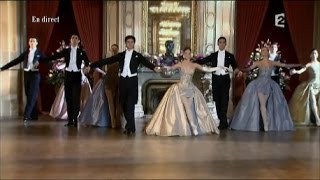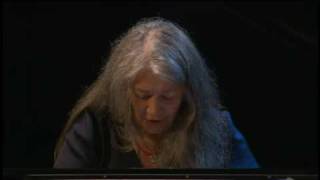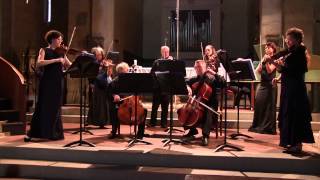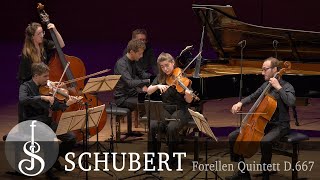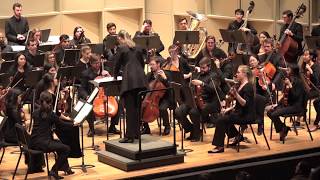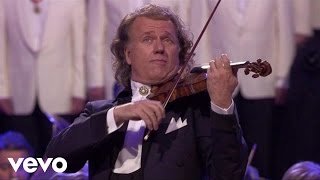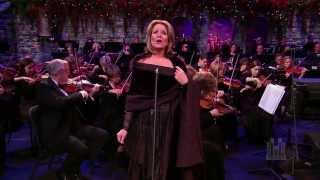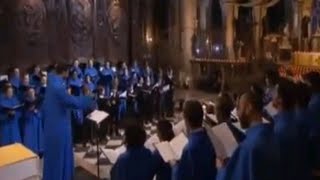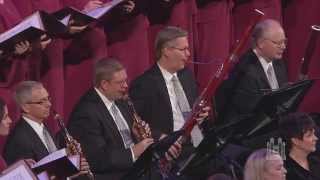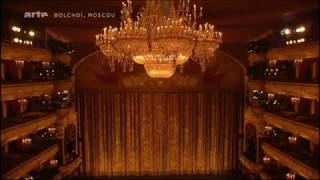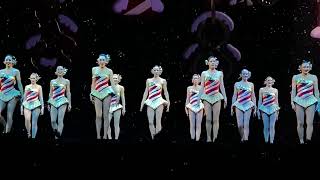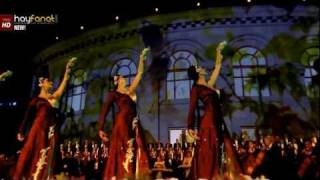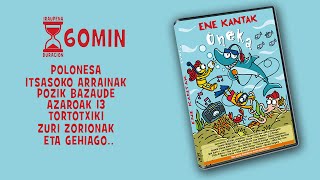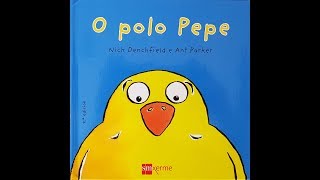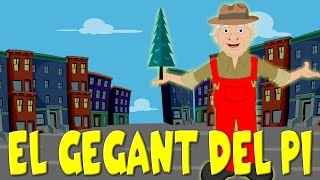
el terrorismo genocida que viene ejerciendo el
Estado de Israel contra el Pueblo Palestino
El 31 de Diciembre se celebra el Fin de Año y comienzo del Año Nuevo
Sugerencias de iniciación a la música clásica
Johann Strauss I (Viena 1804-Viena 1849) fue un compositor austriaco conocido particularmente por sus valses, que rivalizaron en su época con los de Josef Lanner. Fue el primero de una dinastía musical de la que formaron parte sus hijos Johann Strauss II, Josef Strauss y Eduard Strauss. Su obra más famosa es probablemente la Marcha Radetzky (llamada así por Joseph Radetzky von Radetz), que hoy ofrecemos en versión de la Filarmónica de Viena conducida por el maestro argentino Daniel Baremboim.
Ludwig van Beethoven (1770-1827) junto con Bach y Mozart forma parte del trío de gigantes de la música occidental. Nacido en Bonn, su padre, de origen flamenco, intentó exhibirle como un segundo Mozart, aunque fue un notable fracaso. A pesar de ello, a partir de los nueve años el organista Christian Gottlob Neefe, le cautivó con el estudio de Bach a quien siempre le tendría presente. En 1787 se trasladó a Viena con la intención de recibir clases de Mozart, pero el fallecimiento de su madre le devolvió a Bonn a los pocos días. Y así tras cinco años, volvió a Viena donde pudo estudiar con Haydn y Salieri. Sin embargo su profesión de excelente pianista no pudo realizarse debido a la sordera que le atacó al año siguiente hasta dejarle totalmente incapacitado de dicha facultad.
El Concierto para piano n.º 2 en si bemol mayor, Op. 19 de Ludwig van Beethoven, fue compuesto principalmente entre 1787 y 1789, a pesar de que no alcanzó su forma definitiva hasta que fue publicado en 1795. El concierto se convirtió en una pieza para el lucimiento del propio Beethoven tras mudarse de Bonn a Viena. Beethoven fue el solista en su estreno el 29 de marzo de 1795, en el Burgtheater de Viena en un concierto que marcó su debut en público. Mientras que la obra en conjunto sigue el estilo de Mozart, hay un sentido del drama y el contraste que estaría presente en muchas obras posteriores de Beethoven. El concierto consta de tres movimientos, de lo cuales hoy ofrecemos el tercero, un rondó que nos transmite la alegría del joven compositor.
Martha Argerich (1941) es una pianista argentina referente de su generación, quien ya a los cuatro años ofrece su primer recital público y a los siete, el Concierto para piano y orquesta nº 20 de Mozart. Tras sus estudios académicos de piano en Buenos Aires y Viena, realizó puntuales cursos de perfeccionamiento con eminentes maestr@s. A lo largo de su carrera ha sido galardonada con innumerables premios y reconocimientos nacionales e internacionales; tiene en su haber numerosas grabaciones y ha actuado en las salas más importantes tanto como solista como bajo las batutas más relevantes.
Georges Bizet (1836-1875) fue un pianista y compositor francés que en vida no obtuvo demasiados éxitos. Bizet ganó varios premios a lo largo de su brillante carrera como estudiante en el Conservatorio de París, incluyendo el prestigioso Premio de Roma en 1857. Fue reconocido como un pianista excepcional, aunque prefirió no aprovechar su habilidad y en raras ocasiones tocó en público. Su ópera más conocida, Carmen, alcanzó un sensacional éxito en su estreno que no llegó a disfrutarlo pues murió a los tres meses del mismo de un ataque cardíaco a los 39 años. El resto de sus obras fue arrinconado y rescatado poco a poco en el siglo XX. A pesar de ello, en la actualidad está considerado como un referente del siglo XIX y un compositor brillante e imaginativo.
Carmen es una ópera dramática en cuatro actos con música de Georges Bizet y libreto en francés de Ludovic Halévy y Henri Meilhac, basado en la novela Carmen de Prosper Mérimée; la acción transcurre en la Sevilla de 1820 protagonizada por una bella e impulsiva gitana de fuerte carácter.
El Bombardino es un instrumento de viento metal que juega el papel de barítono-tenor en las Orquestas de Viento o Bandas de Música; también se le conoce como Eufonio (“dulce sonido”), lo que resalta el carácter de su sonido propio para hacerse cargo de las partes cantábiles que correspondan a la tesitura indicada. El papel que cumple el violonchelo en una orquesta, lo cumple el bombardino en la Banda de Música.
Hoy presentamos una fantasía de la ópera conformada por algunos de los temas más destacados de la misma e instrumentada para un dúo de bombardinos acompañados por un piano que en la presente ocasión los personifican Steven Mead & Misa Mead con Tomoko Sawano.
Juan José Colomer (1966) es un compositor con doble nacionalidad, española y estadounidense, nacido en Alcira, Valencia, y residente en Los Ángeles, USA, desde 1992. Realizó sus estudios musicales en la Sociedad Musical de Alcira y en el Conservatorio Superior de Música de Valencia, donde obtuvo los Títulos de Grado Superior de Trompeta y Grado Medio de Composición. En 1990 se traslada a Boston, donde profundiza sus estudios en Berklee College of Music en la especialidad de música para películas. Ha recibido encargos de la Orquesta Nacional de España, International Horn Symposium, Centro para la difusión de la música contemporánea (CDMC), International Philip Jones competition (Guebwiller, Francia), Fundación Autor, Spanish Brass y el Instituto Valenciano de la música.
El Tam-bolero es una original y espectacular fusión musical del villancico El pequeño tamborilero con el Bolero de Maurice Ravel. El título mismo es una fusión de los títulos de ambas obras; su autor es el compositor y arreglista Juan José Colomer.
Sugerencias de música clásica
Arcangelo Corelli (1653-1713) fue un violinista y compositor del período barroco italiano. Nacido en Fusignano (provincia de Rávena), desde la infancia estudiaba violín en su ciudad natal. En 1666 viaja a Bolonia, donde estudia con Giovanni Benvenuti y Leonardo Brugnoli. Cinco años más tarde se establece en Roma, donde alcanzaría una extraordinaria fama como violinista, a la vez que perfeccionaba su técnica compositiva. Para 1700, era ya primer violinista y director de conciertos del Palacio de la Cancillería y en 1706 ingresó en la Academia de la Arcadia. Hoy está considerado como uno de los más grandes precursores de la sonata preclásica y el representante por excelencia del concerto grosso. Su música ejerció una gran influencia en los compositores alemanes, especialmente en Bach y Händel.
Catálogo de las obras de Corelli. Sus obras vienen clasificadas por su número de Opus (del latín opus 'obra'; op. abreviatura) que es un término que se utiliza en música para catalogar las obras de la mayoría de compositores desde el siglo XVII.
El concerto grosso (en plural, concerti grossi) era una forma instrumental barroca de origen italiano basada en la contraposición entre un pequeño grupo de solistas (concertino) y una orquesta completa (ripieno o tutti). El concerto grosso data aproximadamente de 1670 y puede atribuirse a Alessandro Stradella, quien parece haber escrito la primera obra musical en la cual un "concertino" y un "ripieno" se enfrentan de forma característica, a pesar de no usar el término concerto grosso. Giovanni Lorenzo Gregori es el primer compositor en utilizar el término concerto grosso y Arcangelo Corelli su representante principal.
Los 12 concerti grossi, op. 6 conforman una colección de doce conciertos compuestos por Arcangelo Corelli (1653-1713) probablemente en la década de 1680 aunque no estuvieron preparados para su publicación hasta 1714. Los doce conciertos se dividen en conciertos de iglesia (I-VIII) y conciertos de cámara (IX-XII). Cada uno de ellos está estructurado en 4, 5 o incluso 6 tempos; además, en los conciertos de cámara se utilizan danzas como la gavota, la zarabanda, la corrente, el minueto, la alemanda y la giga. El conjunto orquestal está formado por el concertino (un primer violín, un segundo violín y un violonchelo concertantes) y los 'grosso' de la orquesta (violines de ripieno, viola, violonchelo y contrabajo); el bajo continuo está formado por el clavicémbalo al que se le puede sumar el órgano portátil y el laúd.
El Concerto Grosso op.6, n.3 in C minor que hoy ofrecemos está estructurado en cinco movimientos: I (0´22´´) LARGO .-. II (2´52´´) ALLEGRO .-. III (4´59´´) GRAVE .-. IV (6´47´´) VIVACE .-. V (9´20´´) ALLEGRO y nos lo interpreta la Orquesta de Cuerda "ORTensemble" con Chiara Morandi como violin conductora.
Franz Schubert (1797-1828) fue un compositor austríaco que a los 11 años fue admitido como miembro del coro de la Capilla Imperial de Viena en la que tuvo como profesor a Salieri. En esa época lo que reportaba dinero era el teatro, la ópera, género en el que nunca logró sobresalir; así que se volcó en los lieder (canciones), entre los que hay que destacar su Ave María y el conjunto de lieder La Bella Molinera. A pesar de morir a los 31 años, dejó escritas más de 1.500 obras entre numerosas piezas de piano y de música de cámara, 8 sinfonías, obras concertantes, música incidental, música sacra (entre otras, 7 Misas, 1 Oratorio y 1 Réquiem), varios singspiel (pequeñas operetas), algo de ópera y más de 600 pequeñas obras vocales, fundamentalmente los lieder citados.
Un quinteto para piano es una obra de música de cámara escrita para piano y otros cuatro instrumentos, comúnmente un cuarteto de cuerda. El término también se refiere al grupo de músicos que toca un quinteto de piano. El género floreció durante el siglo XIX.
Das Forellen Quintett (Quinteto La Trucha) es el nombre que se suele usar para designar el Quinteto para piano en La mayor de Franz Schubert, catalogado como D. 667. La obra fue compuesta en 1819, cuando Schubert contaba con 22 años, pero no se publicó hasta 1829, un año después de su muerte. La pieza debe su nombre a su IV Movimiento, que es un conjunto de variaciones sobre un tema escrito por Schubert anteriormente en su lied Die Forelle (La trucha). Su estructura está articulada en cinco movimientos: I (0´00´´) ALLEGRO VIVACE en forma sonata (exposición-desarrollo-reexposición) .-. II (12´33´´) ANDANTE .-. III (18´57´´) SCHERZO. PRESTO .-. IV (22´36´´) TEMA CON VARIAZIONI. ANDANTINO .-. V (29´21´´) ALLEGRO GIUSTO.
La interpretación de hoy corre a cargo de Mathieu van Bellen, Violín .-. Noga Shaham, Viola .-. Ori Epstein, Chelo .-. Naomi Shaham, Contrabajo .-. Omri Epstein, Piano .-.
Ariel Ramírez (1921-2010) es una de las figuras más relevantes del nativismo argentino. Estudió piano y composición, y a los 20 años, animado por Atahualpa Yupanqui, viajó por todo el país contactando con las distintas expresiones musicales de cada región. Nueve años más tarde realizó un viaje de cuatro años por Europa ofreciendo variados conciertos de música de su tierra; en su regreso a Argentina formó una compañía formada por músicos y bailarines con la que recorrería el país durante 20 años; tras esta etapa actuó como solista de piano en innumerables recitales en los que intercalaba obras propias. Escribió numerosas canciones y obras entre las que cabe destacar la Misa Criolla mundialmente conocida.
La Cantata, en su origen, es una pieza musical escrita para ser “cantada” por una o más voces solistas con acompañamiento instrumental y articulada generalmente por varios movimientos y en ocasiones, con un coro. Posteriormente la cantata va evolucionando y adoptando formas y complexiones más libres, como en el caso que hoy nos ocupa.
Navidad Nuestra es una cantata con letra de Félix Luna y música de Ariel Ramírez estructurada en seis escenas o movimientos musicales: I (0´04´´) LA ANUNCIACIÓN .-. II (4´15´´ ) LA PEREGRINACIÓN .-. III (10´03´´) EL NACIMIENTO .-. IV (16´32´´) LOS PASTORES .-. V (18´45´´) LOS REYES MAGOS .-. VI (21´16´´) LA HUÍDA.
Hoy nos lo ofrecen el Choir of Opera & Philharmonic of Bialystok acompañado por el grupo musical polaco Sierramanta conducid@s tod@s por la maestra Violetta Bielecka
Amy Beach (1867-1944), nacida en el pequeño poblado de Henniker estado de Nuevo Hampshire, fue una pianista y una de las primeras compositoras de la historia de USA. Creció en un ambiente familiar musical en el que su abuela cantaba en el coro de la Iglesia y su madre era cantante y pianista a la que Amy pasaba horas escuchándola. A los cuatro años se inició con el piano y compuso sus primeros valses para piano; sin embargo, debido a que su madre no quería generar un rechazo, no sería hasta los seis años cuando comenzó a darle clases formales de piano. A los 14 años empezó a estudiar armonía y contrapunto y a los 16 años hizo su debut como pianista en un teatro de Boston tocando el Rondó en Mi bemol mayor de Chopin y el Concierto No. 2 de Ignaz Moscheles, debut exitoso que le reportó futuros contratos. Tras varias giras por Europa, decidió asentarse en Nueva York para el resto de su vida, dedicando los inviernos a hacer giras y los veranos a componer en su casa de campo de Massachusetts. Falleció en Nueva York a los 77 años.
Sinfonía gaélica (Sinfonía en Mi menor, Op. 32) su nombre le viene de que varios de sus temas proceden de canciones populares irlandesas. Fue la primera sinfonía escrita y publicada por una compositora estadounidense siendo estrenada con gran éxito el día 30 de octubre de 1896 por la Orquesta de Boston; durante la vida de Beach se interpretó en numerosas ciudades como Chicago, Filadelfia, Detroit, Hamburgo y Leipzig. En 1894, Amy Beach empezó a trabajar en esta obra y la acabó dos años después; cuatro de los temas de la Sinfonía eran tradicionales irlandeses, y Amy citó esta música como una herencia que pertenecía a lo que en esos momentos se estaba definiendo como música popular.
La obra está estructurda en cuatro movimientos: I (0´34´´) ALLEGRO CON FUOCO.-. II (10´49´´) ALLA SICILIANA–ALLEGRO VIVACE .-. III (18´20´´) LENTO CON MOLTA ESPRESSIONE .-. IV (31´05´´) ALLEGRO DI MOLTO. Amy utilizó como fuente para esta sinfonía una colección publicada en 1841 por un colector de canciones folk de Dublín. Sin embargo el primer y segundo temas que aparecen en la sinfonía eran suyos, extraídos de obras anteriores. El tema del segundo movimiento es de una canción de amor irlandesa, primero presentado por el oboe solo, luego con todo el viento madera, y luego con la cuerda. Para la parte intermedia de este movimiento, Beach transformó este tema en uno mucho más rápido. En el tercer movimiento aparecen otros dos temas irlandeses, variados, desarrollados y combinados. El Movimiento final aparece brillante y enérgico reafirmando el tono épico èpico y nacionalista de la Sinfonìa.
Hoy nos la ofrece la Stony Brook Symphony Orchestra conducida por la maestra Michelle Merrill, directora estadounidense nacida en Dallas que ha sido durante cuatro años directora asociada de la Sinfónica de Detroit; ha dirigido, además, la Sinfónica de Indianápolis, de Toronto, de Jacksonville, la Filarmónica de la Ciudad de Oklahoma, la de Luisiana, la de Orlando, la Filarmónica y Ópera de Sacramento, la de Boise, New Music Detroit y la del Noreste de Pensilvania. Actualmente es la titular de la Coastal Symphony of Georgia.
Sugerencias de música para todos los gustos
Sugerencias de videos peculiares
Giselle es un ballet en dos actos con música del compositor francés Adolphe Adam, coreografía de Jules Perrot y Jean Coralli y libreto de Théophile Gautier y Jules-Henri Vernoy, basado en la obra De l'Allemagne (1835) de Heinrich Heine. Giselle es una campesina de gran belleza y extremada inocencia; engañada y traicionada, cae en una desesperación que la arrastrará hacia la locura y la muerte. Giselle es una de las obras maestras del ballet blanc, escena de ballet en la que aparecen vestidas de blanco todas las integrantes del cuerpo de baile. Desde los tiempos del ballet romántico estas escenas de ballet blanc están pobladas por fantasmas, dríades, sílfides, hadas o criaturas por el estilo.
Hoy presentamos el ballet completo interpretado por Svetlana Zakharova, Roberto Bolle en sus papeles principales acompañadxs del Cuerpo de Baile del Teatro de la Scala de Milán.
Gala de reapertura del Bolshoi. Tras seis años de trabajo faraónico, el teatro reabre sus puertas y ofrece en esta ocasión una gala excepcional dirigida por Dmitri Tcherniakov. Los grandes artistas Plàcido Domingo, Natalie Dessay, Dmitri Hvorostovsky, Violeta Urmana, así como las estrellas, solistas y corps de ballet de la compañía desfilan por el escenario para interpretar extractos de piezas líricas y coreográficas que han hecho famoso el lugar. En el programa se ofrece entre otras: El compromiso en el convento de Prokofiev, el Príncipe Igor de Borodin, Iolanta y El lago de los cisnes de Tchaikovsky, Don Quijote de Minkus... (extractado de Télé Loisirs).
Radio City Music Hall es un teatro, considerado como el más importante de USA, situado en Rockefeller Center en medio de Nueva York. Inaugurado en 1932, dispone de 5931 asientos para otr@s tant@s espectador@s. Desde 1933 el espectáculo navideño Radio City Christmas es repuesto regularmente todos los años con cinco representaciones diarias; espectáculo protagonizado principalmente por las Radio City Rockettes, que es un grupo artístico de bailarinas, Papá Noel y otr@s artistas. Otros grupos de Rockettes viajan y actúan por toda la nación durante los días de Navidad.
La Orquesta Sinfónica y Coro de Kohar tiene su base en Gyumri, Armenia, y fue fundada en 1997 por el mecenas de la cultura armenia Harout Khatchadourian. La primera gran gira de conciertos de Kohar tuvo lugar en el verano de 2002, en Chipre y Líbano. En octubre de 2005, fue el turno de Estambul, en la sala de conciertos Lutfi Kirdar, con más de 7000 armenios y público visitante. Del 28 al 29 de abril de 2006, el Gran Salón del Kremlin de Moscú fue testigo de un entusiasmo sin precedentes con casi 12.000 audiencias armenias, rusas y extranjeras. Su concierto más grande con Stars of Armenia lo presentó en Liberty Square cerca de la Ópera en el corazón de Ereván, Armenia, el 28 de mayo de 2011.
En la actualidad Kohar se ha convertido en una piedra angular para la diáspora armenia, con el objetivo de revivir y promulgar la cultura armenia y preservar su herencia para las generaciones futuras en el país y en el extranjero.
Sugerencias de música para niñ@s
Para la realización de estos textos se han utilizado diferentes artículos de la Wikipedia e informaciones puntuales de la Inteligencia Artificial.
Los textos de Videomusicalis están realizados en euskera, castellano e inglés.




